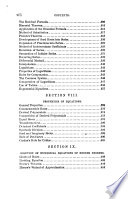 | Silas Totten - 1836 - 320 páginas
...6 + 10=8+8, or 2x8. (62.) 2d. In an increasing' arithmetical progression, the last term is equal to the first term, plus the common difference multiplied by the number of terms less 1 ; and in a decreasing arithmetical progression, the last term is equal to the first, minus the common... | |
 | Davis Wasgatt Clark - 1844 - 394 páginas
...d } number of terms. These four formulas may be enunciated as follows; 1. The last term is equal to the first term, plus the common difference multiplied by the number of terms less one. 2. The first term is equal to the last term, minus the common difference multiplied by the number of... | |
 | Davis Wasgatt Clark - 1846 - 374 páginas
...d ) number of terms. These four formulas may be enunciated as follows; 1. The last term is equal to the first term, plus the common difference multiplied by the number of terms less one. 2. The first term is equal to the last term, minus the common difference multiplied by the number of... | |
 | James Cornwell - 1855 - 380 páginas
...equals the first, plus twice the common difference; and generally, any term in the series is made up of the first term, plus the common difference multiplied by the number of terms before it. Observation. — If the word minus be substituted }or plus throughout this proposition,... | |
 | George Augustus Walton - 1864 - 364 páginas
...TERMS. If, in series (1.) we subtract the first term from the last, we have remaining 5X2, that is, the common difference multiplied by the number of terms less one. Hence, I. To find the common difference : Divide the difference be~ tween the jftrst and last term by the... | |
 | George Augustus Walton - 1864 - 376 páginas
...TERMS. If, in series (1.) we subtract the first term from the last, we have гг* maining 5X2, that is, the common difference multiplied by the number of terms less one. Hence, I. To find the common difference : Divide the difference between the first and last term by the number... | |
 | Horatio Nelson Robinson - 1864 - 444 páginas
...extremes are called arithmetical means. 34:9, In an Arithmetical Progression, the last term is equal to the first term, plus the common difference multiplied by the number of tei-ms lens 1. Let a denote the first term, I the last term, d the common difference, and n the number... | |
 | Horatio Nelson Robinson - 1868 - 430 páginas
...called arithmetical means. 349. In an Arithmetical Progression, the last term ù equal to the ßrst term plus the common difference multiplied by the number of terms less 1. Let a denote the first term, I the last term, d the common difference, and n the number of terms... | |
 | Horatio Nelson Robinson - 1875 - 430 páginas
...extremes are called arithmetical means. 349. In an Arithmetical Progression, the last term is equal to the first term plus the common difference multiplied by the number of terms less 1. Let a denote the first term, I the last term, d the common difference, and n the number of terms;... | |
 | Milton Browning Goff - 1876 - 462 páginas
...difference when the first term is 3, and the 22d term is 45 ? SOLUTION. — Since the last term is equal to the first term plus the common difference multiplied by the number of terms less one, if we subtract 3 from 45, we must have left the common difference multiplied by the number of terms... | |
| |